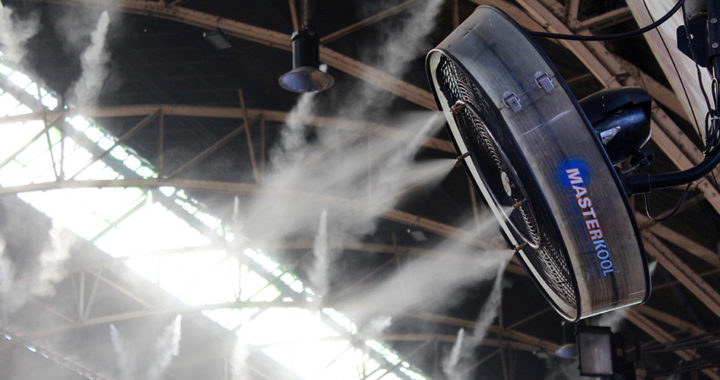An evaporative cooler, also known as a swamp cooler, air cooler, or desert cooler, is an electrical appliance used for cooling ambient temperature through humidification or more specifically, through the evaporation of water, thus resulting in an increase in humidity or the addition of moisture in the air.
When used in an appropriate situation, evaporative coolers offer considerable advantages over vapor-compression or refrigerant-based air conditioning units and dehumidifiers. However, the fact that an evaporative is also a humidifier means that it has limitations and disadvantages under specific circumstances.
Benefits: The advantages of evaporative cooler
1. Cost-effective due to cheaper price and energy efficiency: Some of the notable advantages of an evaporative cooler over a traditional air conditioning unit include a more affordable price and lower energy consumption.
A unit of an evaporative cooler costs about 50 percent less than a traditional window-type air conditioner and about 70 percent to 90 percent less than an inverter-type air conditioner. Moreover, an evaporative cooler consumes 50 percent to 90 percent less electricity than an air conditioner.
2. Easier and cost-effective installation and maintenance: The simplicity of an evaporative cooler or swamp cooler when compared to an air conditioner also translates to cheaper installation and maintenance costs. It does not have a compressor and operation revolves chiefly around a fan and a water pump. There are also no special working fluids, especially refrigerants.
Note that the installation of an air conditioning system requires specialized skills and thus, the services of a professional installation service provider, particularly an HVAC contractor.
3. Better suited for dry and arid climates: Remember that an evaporative reduces air temperature through humidification or more particularly, by increasing the moisture level in the air. Hence, an evaporative cooler works best in areas with dry and arid or desert climates such as the Middle East, North Africa, West Australia, and the American Southwest. This is the reason why an evaporative cooler is also known as a desert cooler.
The aforementioned advantage translates to several specific benefits including improving comfort and decreasing static electricity problems. There are also some health benefits as well. Dry weather dries out the lining of the nose and throat, thus resulting in respiratory distress. It is also important to note that low humidity can damage wooden furniture and can shrink paper-based products such as books and artworks.
Limitations: The disadvantages of evaporative cooler
1. Not as effective as air conditioners in terms of cooling: An evaporative cooler or swamp cooler cannot lower the ambient temperature as much as a vapor-compression or refrigerant-based air conditioning units. In other words, it is not as effective and as efficient as air conditioners in terms of cooling capacity.
For example, an air conditioner can bring down the temperature to as low as 20 degrees to 16 degrees Celsius while an evaporative cooler can lower down the temperature to only around 25 degrees to 20 degrees Celsius. Under a hot and humid weather, an evaporative cooler cannot provide similar thermal comfort. In fact, because it increases humidity in the air, it can actually increase discomfort. There is also a need to use this electric appliance alongside exhaust ducts or open windows, or in the open air to maximize its efficiency.
2. Unsuitable for use in areas with high humidity: Remember that an evaporative cooler humidifies or increases the moisture in the air. In areas with high relative humidity or during hot and humid weather, using this electronic appliance can increase thermal discomfort.
It is counterproductive to use an evaporative cooler in hot and humid weather because of its inability to effectively lower down the temperature and provide acceptable thermal comfort. In other words, its operation results in the nonproductive use of electricity.
When traditional air conditioners are not an option, the best alternative to an evaporative cooler is a dehumidifier that does the opposite—improves temperature in a hot and humid environment by reducing and maintaining the level of humidity in the air.
3. Several drawbacks and limitations due to humidity: Some of the noteworthy disadvantages of evaporative cooler center on the various problems that come with high humidity. For starters, overusing this electric appliance can result in the excessive humidity build up, thus promoting the growth of dust mites, and mold and mildew in a confined space.
There are also health drawbacks as well. High humidity in a confined space can result in a condition called hypersensitivity pneumonitis or trigger asthma and other allergic problems due to the presence of mold and mildew, or bacteria in the damp air. Note that when not properly maintained, the water tank of an evaporative cooler can also be a breeding ground for pathogens and mosquito.
Other limitations and drawbacks of evaporative cooler, especially when used excessively or under a hot and humid weather, include damage to wood-based and paper-based materials due to the growth of mold and mildew, reduced lifespan of electronics because high humidity promotes and accelerates the corrosion of electronic components, and susceptibility to condensation due to high humidity that can also damage electronics, as well as wood-based and paper-based materials.
Summary: The advantages and disadvantages of evaporative cooler
The benefits and advantages of an evaporative cooler, also known as swamp cooler, air cooler, or desert cooler include inexpensive price and lower energy consumption, as well as easier and inexpensive installation and maintenance, when compared to traditional air conditioners; and suitability for use in dry and arid climates, especially during hot and dry weather conditions.
On the other hand, the disadvantages of an evaporative cooler center primarily on the negative impacts of too much humidification. These disadvantages translate further to more specific limitations and drawbacks. For example, using an evaporative cooler for prolonged period of time or under a hot and humid weather increase health-related risks such as respiratory distress, as well as the susceptibility of wood-based, paper-based, and electronic products
